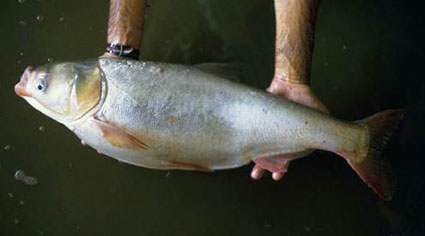Bighead Carp (Hypophthalmichthys nobilis) and Silver Carp (Hypophthalmichthys molitrix)
Carp and minnow fish family (Cyprinidae)
Bighead and silver carp are native to Asia, specifically eastern China through Siberia and into North Korea. However, bigheaded carp (bighead and silver carp, collectively) have expanded throughout Asia.
Expanded Range:
Bighead carp and silver carp were introduced in the early 1970s in Arkansas to a farmer trying to improve water quality and production in culture ponds. Eventually, the Asian carp escaped from holding facilities into nearby wetlands, streams, rivers and ponds. The first bighead carp in natural waters in the United States was found in 1981 in the Ohio River in Kentucky. In 1989, reproduction was documented in natural waters with the discovery of a young bighead carp in Missouri, and postlarval fish were found in southern Illinois in 1992. The bighead carp population has been increasing since, ranking fourth in total commercial harvest on the Missouri portion of the Mississippi River Basin by 1998. Today, the bighead carp has been recorded in 23 states.
Along the Gulf coast, bighead carp have made their way into all states from Florida to Texas. Currently, silver carp are only known to be in Louisiana. In their expanded range, bigheaded carp can reach high densities, outcompeting native fishes.
For a current map depicting bighead carp and silver carp distribution, visit the U.S. Geological Survey Nonindigenous Aquatic Species Site:
Bighead carp have been recorded at 80 pounds. Silver carp can reach 60 pounds. Both species are deep bodied with eyes far forward, along the midline of the body. Silver carp, nicknamed the flying fish, can jump 10 feet in the air when disturbed by water crafts, making them a threat to boaters. Bigheaded carp are very fecund and have rapid growth rates. Silver carp can reach over 2 pounds in less than a year, and bighead carp over 6 pounds in one year. Both mature adults can have more than half a million eggs each year.
Both species are filter feeders consuming plankton. One major concern is the competition for food with native fish, such as the paddlefish, bigmouth buffalo and larval catfish. Silver carp and bighead carp were added to the federal injurious wildlife list in 2007 and 2010, respectively, which under the Lacey Act prevents the transport or import of live, viable eggs or hybrids of the silver carp and bighead carp across state lines. There is great concern that Asian carp will soon enter the Great Lakes.
How to help:
Eat them! Asian carp have a great flesh. However, they are extra bony. Techniques to fillet them are demonstrated below:
Louisiana Sea Grant is also trying to use this invasive to provide a protein source for Haitians in need: www.laseagrant.org/comm/2010/asiancarp.htm.

Bighead Carp.
Photo credit: USGS (http://el.erdc.usace.army.mil/ansrp/ANSIS/html/hypophthalmichthys_nobilis_bighead_carp.htm)

Silver Carp.
Photo credit: USGS
(http://nas.er.usgs.gov/queries/factsheet.aspx?SpeciesID=549)
Additional information: